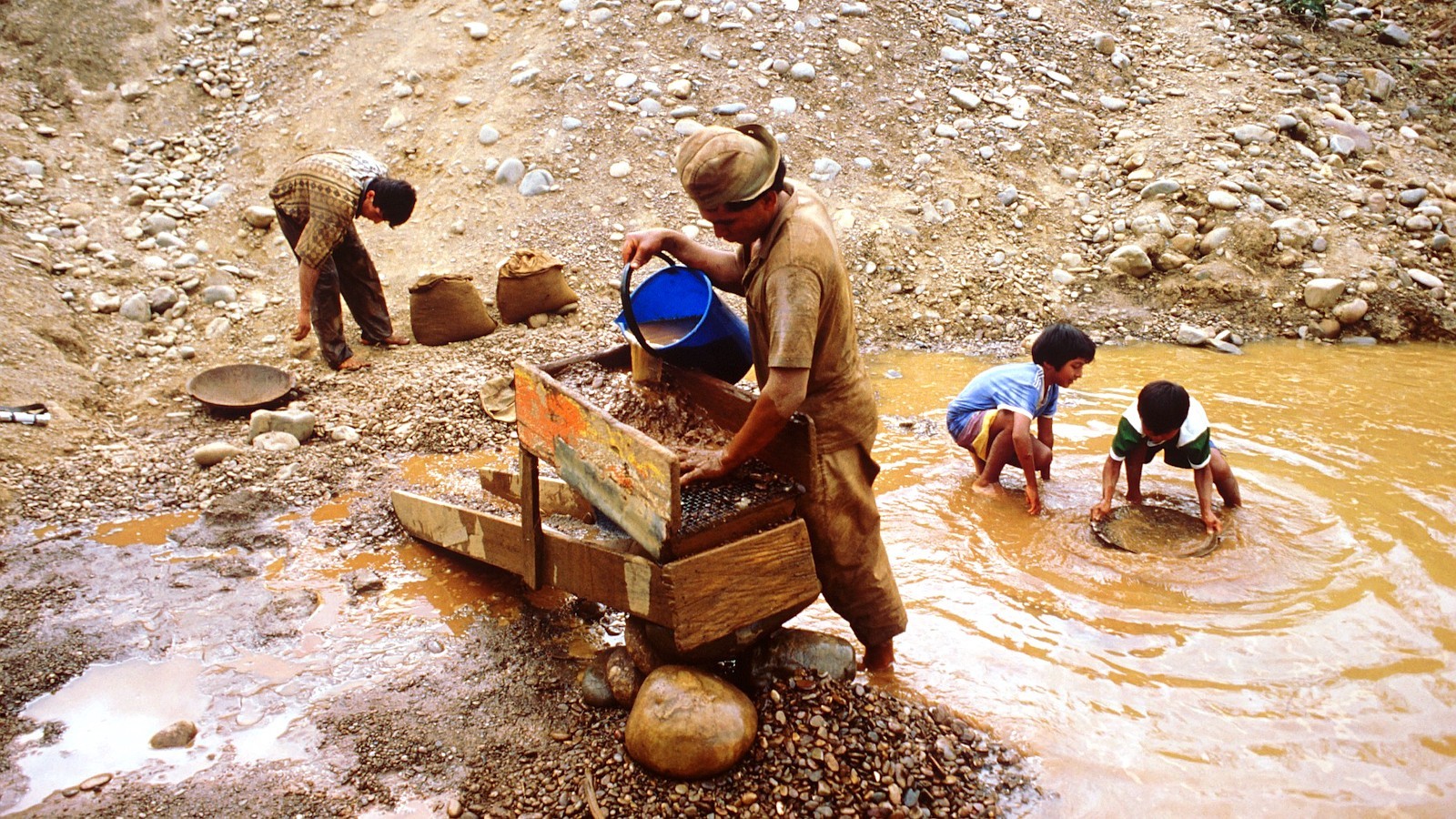All through Bolivia, even in protected areas acknowledged by the United Nations for his or her number of wildlife, higher than 1,000 artisanal mining operations are razing bushes, diverting waterways, and reshaping the land of their look for gold. Whereas miners are making a dwelling, though, they’re moreover dispersing mercury by the use of the air, water, and soil. Their use of mercury has helped propel Bolivia to develop to be the world’s largest importer of the toxic substance.
The Minamata Convention is a worldwide treaty to protect human effectively being and the setting from the outcomes of mercury, considered by the World Properly being Group to be one in all many prime 10 chemical compounds of finest public-health concern. The treaty is called for Minamata Bay, Japan, the place industrial dumping of mercury inside the Nineteen Fifties and ’60s led to widespread starting defects, neurological points, and deaths as of us consumed tainted fish. Like most South American nations, Bolivia signed the convention, which acquired right here into influence in 2017 and requires nations to develop a nationwide movement plan to chop again and, the place attainable, take away mercury use in artisanal and small-scale gold mining. Nonetheless in distinction to totally different nations, Bolivia has accomplished almost nothing to handle the import or use of mercury.
Closing yr, gold was Bolivia’s prime export, value $2.5 billion — double the price in 2020.
Bolivia has prolonged been criticized by environmental and civil society groups for its lax regulation of the issue, of which the overwhelming majority is used for gold mining. Closing yr, Marcos Orellana, a professor of environmental regulation at George Washington School who’s the UN’s explicit rapporteur on toxics and human rights, urged the Bolivian authorities to take movement in the direction of the mercury commerce, noting that its technique “has generated extreme impacts on the human rights of populations affected by mercury contamination, along with members of Indigenous peoples.”
In response, Bolivia’s authorized skilled regular defended the nation’s adherence to the Minamata Convention, citing pilot functions amongst miners to elevate consciousness of the outcomes of mercury and to promote totally different utilized sciences. Nonetheless little has modified in distant mining camps, and this earlier September, Orellana supplied a report again to the UN’s Human Rights Council that generally known as for a worldwide ban on shopping for and promoting mercury and on using it in small-scale gold mining, which is now the world’s largest provide of mercury air air pollution. He singled out Bolivia as a reported hub for mercury smuggling to totally different nations inside the Amazon Basin. In October, when Orellana was in La Paz, Bolivia’s capital, for a conference on mercury, two Bolivian NGOs launched preliminary findings of their very personal mercury analysis, which confirmed that communities downstream of mining train have irregular and, in some situations alarming, ranges of mercury of their our our bodies.
Gold has prolonged been considered a protected haven for merchants and a hedge in the direction of inflation. Recently, its value hit file highs, and the rise has pushed a surge in mining. Closing yr, gold was Bolivia’s prime export, value $2.5 billion — double the price in 2020.
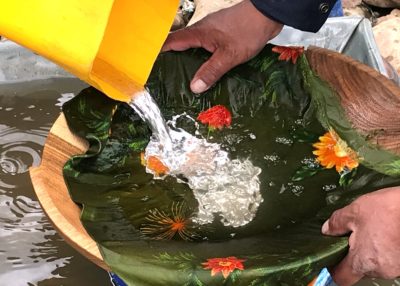
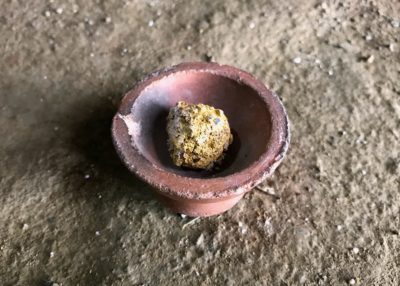
Left: Mercury is poured by miners on a clump of earth to amalgamate gold particles. Correct: A lump of gold and mercury.
Thomas Graham
Practically all of Bolivia’s gold mining, carried out by unionized mining “cooperatives” working every legally and illegally, takes place inside the La Paz space, along with inside the mountains and forests of the Apolobamba, Madidi, and Cotapata Nationwide Parks, which lie north and northeast of the nation’s capital. In Bolivia, as in a variety of the Amazon, gold occurs at low concentrations inside the earth and in riverbeds. Practices differ, nonetheless miners often use heavy tools to excavate monumental portions of cloth, or hoses to suck up sediment from the riverbed, then course of this gold-bearing soil and water by the use of a sluice system that concentrates the gold. The miners then add liquid mercury to a slurry of gold and sand. The metallic binds with the gold, forming an amalgam. Miners discard the tactic water and tailings, which nonetheless comprise some mercury, then heat the amalgam, vaporizing the portion that is mercury and forsaking purer gold.
Mercury leads to human our our bodies by the use of two distinct pathways. The first is when miners, most of whom work with out defending masks, vaporize mercury and inhale fumes. This will likely more and more happen on the placement of a mining operation or the place gold patrons further refine small nuggets of ore of their shops, dispersing fumes by the use of populated areas.
There is not a single internationally accepted limit for mercury ranges in folks, although the U.S. Environmental Security Firm has set a protected limit of 1 half per million (ppm), as measured in hair samples. Mercury emissions could possibly be human-caused or consequence from pure processes: the issue is emitted into the air when forests burn, volcanoes erupt, and rocks local weather. In 2018, the United Nations carried out a worldwide mercury analysis and concluded that in most background populations — that is, amongst of us with out essential mercury publicity — the extent tends to be decrease than 2 ppm.
Members of 1 Indigenous neighborhood reported pains of their muscle tissues, heads, and stomachs after mining intensified upstream.
“That being talked about, we don’t assume there’s any protected stage of mercury,” talked about Professor Niladri Basu, an environmental toxicologist at McGill School who was part of the analysis. “There are case analysis throughout which of us will exhibit mercury inside the hair lower than 2 ppm and current some type of influence.”
Prompted by the intensification of gold mining in Bolivia these days, civil society groups in 2022 carried out two non-peer-reviewed analysis of mercury ranges in riverside populations downstream from mining train inside the Bolivian Amazon. Throughout the Division of La Paz, the Wildlife Conservation Society and Reacción Climática took hair samples from 268 of us from 27 communities and 5 Indigenous groups. The everyday mercury stage of all people examined was 2.96 ppm, whereas the Esse Ejja, an Indigenous group that eats far more fish than the others, averaged 6.9 ppm. This analysis constructed on a 2021 analysis carried out by the Worldwide Air pollution Elimination Neighborhood, which found that Esse Ejja ladies of child-bearing age had a imply hair mercury stage of seven.58 ppm. The most effective stage was 32.4 ppm.
Moreover in 2022, the Bolivian Center for Documentation and Information took 590 samples from 15 riverside communities inside the two principal watersheds of the Bolivian Amazon, the Beni and the Madre de Díos. All 5 communities alongside the Beni River had a imply mercury stage above 2 ppm, and two had frequent ranges nearer to 7 ppm. The researchers took 112 samples from children beneath the age of 15 in these communities and situated a imply mercury stage of 6.48 ppm. Within the meantime, on the Madre de Díos River, the place gold mining is way much less intensive, all nonetheless one neighborhood had a imply mercury stage above 1 ppm, though none exceeded 3 ppm.
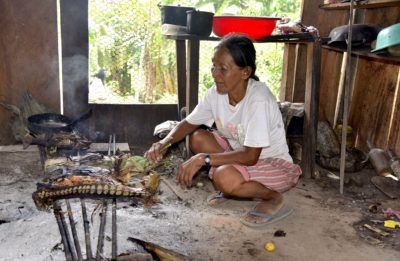
An Indigenous Chiman woman who lives alongside the Beni River cooks fish.
AIZAR RALDES / AFP by way of Getty Images
Neither analysis collected information on the effectively being of people, and researchers drew no conclusions about hyperlinks between poor effectively being outcomes and mercury publicity. The levels observed have been far lower than these observed in Minamata Bay, the place hair mercury ranges ranged from 191 ppm to 705 ppm. Nonetheless, researchers well-known — and people reported — indicators that will very effectively be associated to mercury publicity.
“Throughout the case of children, one in all many indicators is extraordinarily delicate pores and pores and skin and a sort of pink rash on the palms and extremities,” talked about Oscar Campanini Gonzalez, director of the Bolivian Center for Documentation and Information. “And we observed this on the pores and pores and skin of various children which have been nursing.” If confirmed, talked about Campanini, this might recommend publicity to mercury each in utero or by the use of breast milk. Oscar Lurici, a guide of the Esse Ejja, suggested Yale Environment 360 that adults in his neighborhood started to experience new kinds of effectively being points as upstream mining intensified. “They started feeling pains of their muscle tissues, heads, and stomachs,” he talked about. “Typically, infants and the aged have blood of their feces.”
Pál Weihe, who 30 years prior to now led a benchmark analysis on the outcomes of methyl mercury publicity inside the Faroe Islands, the place mercury-contaminated pilot whale was an needed part of the consuming routine, talked about that the indicators being reported in Bolivia amongst adults would not be typical with this stage of mercury publicity. “Nonetheless within the occasion you ask me, is the extent of publicity acknowledged by these NGOs problematic? Then I might say, certain, they should undoubtedly be launched down.”
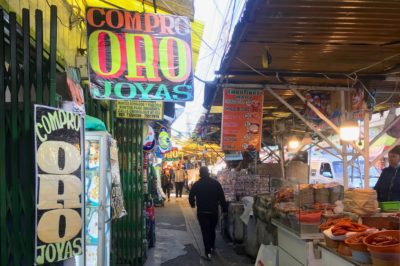
Gold retailers in La Paz, Bolivia.
Thomas Graham
Most likely probably the most urgent function to do this, Weihe talked about, is to protect fetuses which may be uncovered to mercury when mothers eat mercury-contaminated fish. Such publicity can have refined nonetheless eternal neurodevelopmental outcomes. “Individuals are additional vulnerable [to toxic substances] sooner than starting, for certain,” talked about Weihe, now chief physician on the School of the Faroe Islands. “The thoughts is creating. Its construction is taking type.”
Consistent with Campanini, the riverside communities want a medical specialist to analysis potential hyperlinks between mercury publicity and their indicators. As well as they want additional analysis carried out on fish from their rivers, to help them set up which species have lower ranges of mercury. If of us stop consuming mercury altogether, their ranges will slowly fall, consultants say, nonetheless fish consumption is in some other case extraordinarily useful for these populations. “It’s very robust to weigh the neurological hazard that mercury would possibly pose in the direction of the neurological benefits of fish consumption,” talked about Basu.
Lurici, of the Esse Ejja, talked about his Indigenous group solely not too way back found about elevated ranges of mercury of their neighborhood. “Nonetheless we’ll’t be suggested to not eat fish, on account of that’s the neighborhood’s work, its provide of meals. Utterly all people eats fish.”
If communities can’t stop fish, can miners stop, or reduce, their use of mercury? Big-scale miners often use cyanide to leach gold from ore, nonetheless the chemical will be toxic to folks and wildlife. The Bolivian foundation Medmin, which works with miners to boost their environmental practices, and totally different NGOs have labored with 15 mining cooperatives to undertake utilized sciences that forestall mercury air air pollution by decreasing the quantity used after which recycling it. Consistent with Danilo Bocángel Jerez, regular supervisor of Medmin, miners can focus the gold as so much as doable sooner than together with mercury, then heat their amalgam in a closed system that captures after which reliquefies vaporous mercury for reuse.
In 2021, the federal authorities launched it may produce an movement plan for mercury use in July of 2022. The plan has however to appear.
In precept, such utilized sciences might reduce mercury loss to shut zero, and the NGOs are hoping the cooperatives they work with will transfer these lessons to others. Nonetheless there are 1,400 mining cooperatives in La Paz, and further appear yearly. They perform in distant areas, often with out environmental licenses and usually with out licensed concessions. The federal authorities, talked about Marcos Uzquiano, until not too way back the top of security at Madidi Nationwide Park, principally turns a blind eye to these operations. And if it does levy a top quality, the miners pay it and protect working.
Most miners, talked about Alfredo Zaconeta Torrico, a mining expert at CEDLA, a Bolivian assume tank, are unlikely to undertake such utilized sciences of their very personal volition on account of they’re used to working with mercury and are unwilling to make the funding. Moreover, the monetary incentive to reuse mercury is small. “As compared with what they’re incomes with gold, the worth of mercury is nothing,” talked about Zaconeta.
One different technique to chop again mercury use will be regulating it on the extent of import. Zaconeta talked about every importer of mercury must be required to state the place it ought to end up, and if it is going to seemingly be utilized in mining, what environmental practices will most likely be used. Even when such legal guidelines have been flouted, he talked about, they may enhance the worth of mercury and incentivize miners to reuse it. Consistent with Campanini, the Ministry of Environment supplied such a proposal to the Bolivian Cabinet various situations these days, nonetheless the thought was not at all pursued.
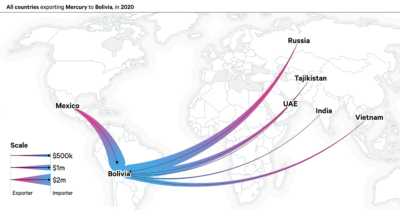
Exports of mercury to Bolivia in 2020 by value in U.S. {{dollars}}.
Chatham Dwelling
Fecoman, the union of cooperative gold miners in La Paz, has talked about it is open to altering utilized sciences, nonetheless offered that the federal authorities pays for it. To this point, the union has blocked proposed mercury regulation by shutting down website guests inside the nation’s capital. Closing yr, gold exports represented 6.2 p.c of Bolivia’s GDP.
In 2021, after UN rapporteurs submitted a 10-page letter to the Bolivian authorities citing the dearth of regulation of mercury and human rights violations in the direction of Indigenous peoples, and suggesting the nation was in breach of the Minamata Convention, the federal authorities launched it may produce an movement plan for mercury use in July 2022. The plan has however to appear, though officers insist it is inside the works.
“We merely want some assist from the federal authorities,” talked about Oscar Lurici, of the Esse Ejja. “Probably they may help of us uncover [alternatives to] fishing. Or possibly help them enhance their very personal fish” on land, one factor the federal authorities has supported as a progress approach elsewhere in Bolivia. Campanini talked about further analysis may also help communities identical to the Esse Ejja set up which fish, from the place, have lower ranges of mercury and are safer to eat.
For now, the Ministry of Properly being has created a toxicology neighborhood, which it says has higher than 100 docs monitoring for indicators of mercury poisoning in areas affected by gold mining. The ministry did not reply to a request for an interview. “The creation of this neighborhood reveals some sort of consideration on the part of the state,” talked about Campanini. “Nonetheless it’s really not the nationwide movement plan required by the Minamata Convention.”
